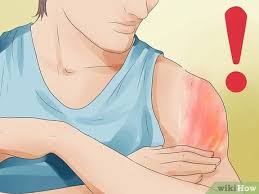
Burns
There are three primary types of burns: first-, second-, and third-degree. Each degree is based on the severity of damage to the skin, with first-degree being the most minor and third-degree being the most severe. Damage includes:
- first-degree burns: red, no blistered skin
- second-degree burns: blisters and some thickening of the skin
- third-degree burns: widespread thickness with a white, leathery appearance
There are also fourth-degree burns. This type of burn includes all of the symptoms of a third-degree burn and also extends beyond the skin into tendons and bones.
Burns have a variety of causes, including:
- scalding from hot, boiling liquids
- chemical burns
- electrical burns
- fires, including flames from matches, candles, and lighters
First-degree burn
First-degree burns cause minimal skin damage. They are also called “superficial burns” because they affect the outermost layer of skin. Signs of a first-degree burn include:
- redness
- minor inflammation, or swelling
- pain
- dry, peeling skin occurs as the burn heals
Since this burn affects the top layer of skin, the signs and symptoms disappear once the skin cells shed. First-degree burns usually heal within 7 to 10 days without scarring
second-degree burn
Second-degree burns are more serious because the damage extends beyond the top layer of skin. This type burn causes the skin to blister and become extremely red and sore.
Due to the delicate nature of these wounds, keeping the area clean and bandaging it properly is required to prevent infection. This also helps the burn heal quicker.
Some second-degree burns take longer than three weeks to heal, but most heal within two to three weeks without scarring, but often with pigment changes to the skin.
The worse the blisters are, the longer the burn will take to heal. In some severe cases, skin grafting is required to fix the damage. Skin grafting takes healthy skin from another area of the body and moves it to the site of the burned skin.
Third-degree burn
Excluding fourth-degree burns, third-degree burns are the most severe. They cause the most damage, extending through every layer of skin.
There is a misconception that third-degree burns are the most painful. However, with this type of burn the damage is so extensive that there may not be any pain because of nerve damage.
Depending on the cause, the symptoms third-degree burns can exhibit include:
- waxy and white color
- char
- dark brown color
- raised and leathery texture
- blisters that do not develop
Without surgery, these wounds heal with severe scarring and contracture. There is no set timeline for complete spontaneous healing for third-degree burns.
Never attempt to self-treat a third-degree burn. While you’re waiting for medical treatment, raise the injury above your heart. Don’t get undressed, but make sure no clothing is stuck to the burn.
Complications
Compared with first- and second-degree burns, third-degree burns carry the most risk for complications, such as infections, blood loss, and shock, which is often what could lead to death. At the same time, all burns carry the risk of infections because bacteria can enter broken skin.
Severe burns also carry the risk of hypothermia and hypovolemia. Dangerously low body temperatures characterize hypothermia. While this may seem like an unexpected complication of a burn, the condition is actually prompted by excessive loss of body heat from an injury. Hypovolemia, or low blood volume, occurs when your body loses too much blood from a burn










